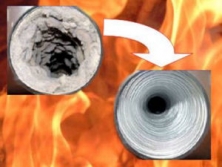
By Fire Chief Sam DiGiovanna
February 20, 2013 (San Diego’s East County)--Who would think that the danger exists in doing such a daily household chore such as laundry? Recent incidents across the country point to the dangers of dryer fires. In fact, on average, over 13,000 fires start in our laundry rooms in the United States each year, resulting in deaths and close to $10 million in property damage says Fire Chief Sam DiGiovanna. Nearly 4,000 of these fires arise from lint buildup and overheated motors that occur when people fail to clean their dryer vents. The following advice can help you prevent a disaster.
When it comes to dryer fires, flexible dryer ducts made of foil or plastic are the most problematic because they can sag and let lint build up at low points. Ridges can also trap lint. Metal ducts, neither flexible nor rigid, are far safer because they don't sag, so lint is less likely to accumulate. What’s more, if a fire does start, a metal duct is more likely to contain it. No matter which kind of duct you have, clean it regularly. Also clean the lint screen each time you use your dryer and get rid of any lint inside, behind, and underneath the dryer. Dryer motors can eventually overheat and catch fire says Chief DiGiovanna. These simple steps will not only reduce the risk of a fire, but your dryer will also dry your clothes faster and use less energy.
Warning Signs
- Dryer is still producing airflow, no heat. It takes longer and longer to dry clothes, especially towels and jeans or any other article of clothing.
- Clothes are damp or hotter than usual at the end of the cycle.
- Outdoor flapper on vent hood doesn't open when dryer is on.
- Airflow in the vent seems low.
Prevent a Possible Dryer Fire!
- Most vents should be cleaned every year. Some dryer vents need attention more often.
- Do not operate the dryer without a lint filter. Clean lint filters before or after each use and remove accumulated lint from around the drum.
- Make sure that the dryer is plugged into an outlet suitable for its electrical needs as overloaded electrical outlets can result in blown fuses or tripped circuit breakers.
- Turn the dryer off when leaving home.
- Keep the dryer area clear of combustibles (i.e., boxes or clothing).
- Have gas-powered dryers inspected by a professional regularly to ensure that the gas line and connection are intact.
Clean your dryer filters and vents from the buildup of fabric material and have a professional check your system. For additional safety information, contact your local fire department!










Recent comments